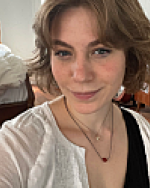
Annie Franklin, a Museum Studies BDP student, collaborated with the Longhorn Wellness Center to develop a series of tours exploring mental health through art at the Blanton Museum.
"I found that art gives people a shared vernacular to talk about their feelings and experiences, allowing them to project themselves onto the piece and the piece onto them.”
Where did you intern?
I interned at the Blanton Museum of Art in Austin, TX.
How did you find this internship?
I initially joined the Blanton as their Plan II Education Intern for my sophomore year. In this role, I participated in their comprehensive gallery teacher training program and started the project that would evolve into my BDP Connecting Experience the following fall semester.
What kind of work did you do as an intern?
In addition to leading regular tours for K-12 visiting groups, I partnered with the Longhorn Wellness Center to develop a series of tours exploring mental health through art. I specifically collaborated with student SHARE facilitators, who are trained to run support-group-modeled SHARE circles. We worked together to develop tours, utilizing the Blanton’s collection as a starting point to talk about our own experiences with subjects such as academic stress, grief, and love. Over the course of the semester, we hosted three sessions, attracting over two dozen student and staff participants.
What was the most rewarding aspect of your Connecting Experience?
The conversations that emerged out of these tours were illuminating for me as both an educator and individual. I found that art gives people a shared vernacular to talk about their feelings and experiences, allowing them to project themselves onto the piece and the piece onto them. I also really enjoyed challenging participants’ idea of how they are supposed to engage with a museum tour. It’s so fun to turn the script and ask the group to lead the tour with me rather than receiving it from me.
In what ways has this Connecting Experience shaped your plans for the future?
This experience expanded my understanding of how museums can and should serve visitors. The structure of the tours we developed fundamentally challenges a purely didactic model of museum education, where the guide delivers information to the group. As I move forward in my career, I will continue to challenge and expand the ways museums engage with their visitors, elevating audience voices as much as possible.
Please discuss the relationship that you had with your faculty mentor(s), and how they helped you during this Connecting Experience.
My faculty mentor, Adrian Lancaster, was such a fun, supportive, and generally lovely partner in this process. They lead the LWC with such passion and vision, and this translates to all the projects they touch. I hope to have as much enthusiasm in my future job as they do in theirs, as this enthusiasm translates to truly inspired work.

